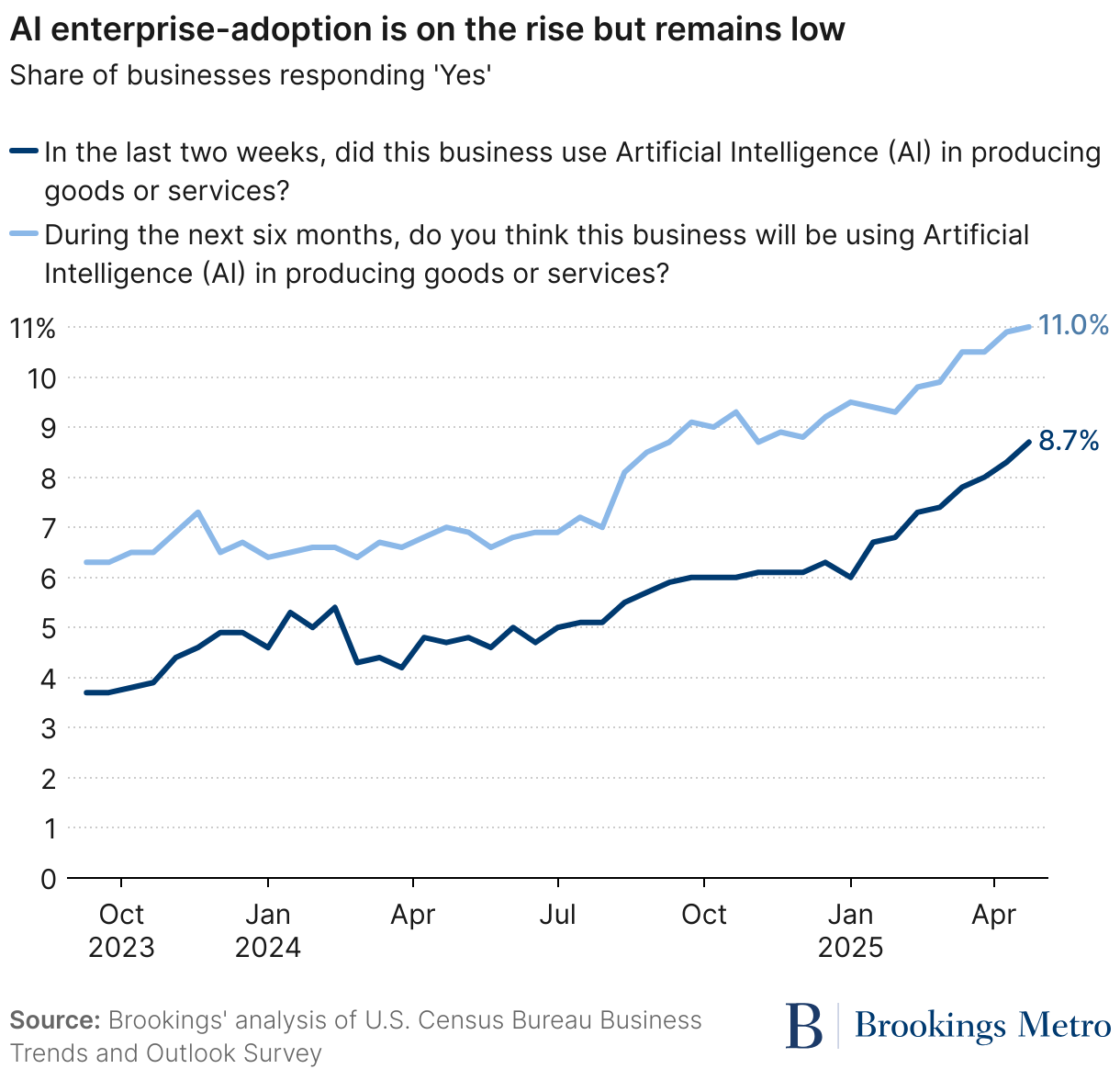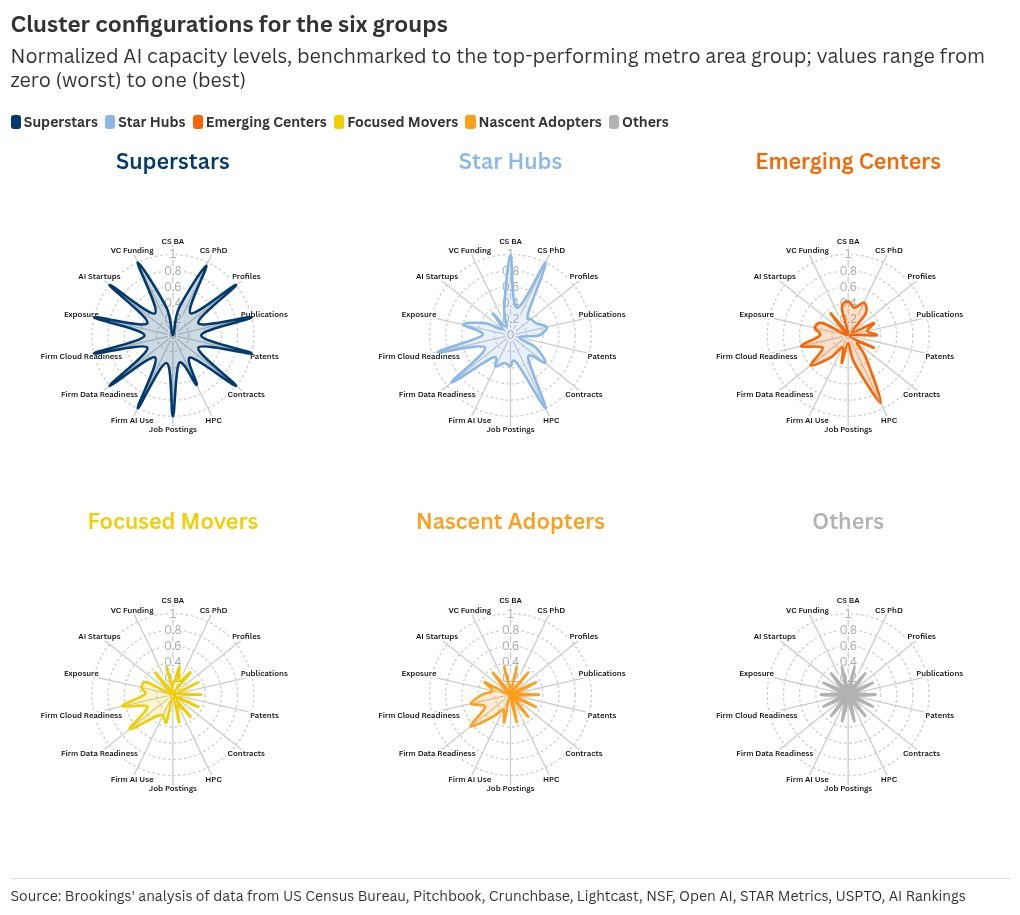AI Insights
Mapping the AI economy: Which regions are ready for the next technology leap

Artificial intelligence has emerged as a general purpose technology with far-reaching consequences for industries, places, and people.
AI systems promise to drive productivity by automating routine tasks or augmenting work, allowing humans to focus on higher-value activities. The technology is also accelerating the pace of discovery and innovation by analyzing vast datasets and identifying patterns humans might miss. And for that matter, AI enables more efficient resource allocation through intelligent forecasting and optimization.
As such, AI could heavily influence the nation’s ability to achieve its larger goals, whether it be through faster drug development, personalized learning, or “virtual employees” optimizing supply chain complexities.
With that in mind, it matters a lot whether and which U.S. cities and regions are prepared to facilitate AI development in high-quality ways, and are therefore demonstrating a readiness to truly benefit from future AI build-out.
What does it mean to be ‘ready’ for AI?
The nation’s general readiness to benefit from AI is critical, because the technology is going to play a significant role in economic development given its potential to drive efficiency, innovation, and productivity in every industry, both nationally and within regions.
Overall, readiness for AI—as an emergent, innovation-driven technology—will depend on the nation’s ability to deliver on these critical pillars:
- The availability of abundant AI talent, since talent clusters are critical in generating self-reinforcing economic growth for people, firms, and places.
- The accessibility of AI innovation and innovation infrastructure, since technical progress plays a disproportionate role in economic growth and builds on itself.
- Actual adoption of AI by organizations, because broad technology adoption remains an important driver of productivity growth and living standards.
AI readiness also matters for regions
At the same time, AI adoption at the regional level matters equally for economic development, prosperity, and the flourishing of communities. Individual places must pay attention to the local presence of the three pillars of AI readiness to ensure their success.
After all, AI very much reflects the tendency of emerging digital industries to cluster in a short list of large, tech-focused “early-adopter” hubs, as Brookings has described in previous reports.
At the same time, digital industries, including AI, tend to gradually diffuse across the country at varied speeds with varied adoption patterns.
In response, this analysis expands on an earlier study to examine the extent, location, and concentration of AI assets, capabilities, and activity in U.S. metropolitan areas.
Employing 14 basic measures, the report benchmarks regions based on their core AI assets and capabilities as they relate to three pillars of AI readiness: talent, innovation, and adoption. In doing so, the assessment categorizes 195 metro areas into six tiers of regional AI involvement and recommends starting points and strategies based on the level and type of involvement.
Read more about our data and methodology on page 6 of the full report. >>
Turning to the results of the assessment, analysis of the 14 measures of AI economic activity across the U.S. yields several broad findings about the industry, its characteristics, and its geography.
The nation’s AI enterprise is growing rapidly, though it remains modest in size
One of the clearest indicators of AI’s expanding footprint in the U.S. economy is the rising share of businesses reporting current or anticipated use of AI technologies.
The main AI enterprise is concentrated in a limited number of metro areas, but numerous other regions are home to meaningful AI activity
Along these lines, the present analysis depicts an AI sector that remains concentrated in the nation’s most familiar coastal tech centers, but is beginning to spread across the country with varying degrees and types of local clustering.
Continuing the pattern Brookings reported in 2021, the major AI community types revealed by the present cluster analysis include:
Superstars: The San Francisco and San Jose metropolitan areas exhibit unmatched strength across all three AI success pillars (talent, innovation, and adoption).
Star Hubs: This group of 28 metro areas forms a second echelon of uniformly strong AI ecosystems, balancing top‑tier talent, research, and enterprise uptake.
Emerging Centers: This group of 14 metro areas combines top performance in two pillars with one developing area.
Focused Movers: This group of 29 metro areas excels in one AI pillar while maintaining foundations in the other two.
Nascent Adopters: This group of 79 metro areas shows moderate performance across all three pillars.
Others: This group of 43 metro areas currently lags on multiple pillars.
In addition, the analysis also touches on 192 of the nation’s smaller metro areas.
As the above map shows, the six cluster types account for varied, disparate chunks of the AI economy, with wide scattering across Eastern, Midwest, and Sun Belt states.
The six cluster types are characterized by varied strengths across the three pillars. In this regard, the two Superstar metro areas reflect broad and dominant strength across all success pillars. Likewise, the Star Hubs group displays its own strong but less dominant balance across the three pillars. The rest of the cluster groups display varied configurations that all tend to reflect modest talent availability, thinner innovation resources, and somewhat stronger adoption activity.
Current and emerging regional AI performance is informed by varied local mixes of success factors
Zooming in on the distribution of individual success factors across the clusters reveals the varied presence of the 14 metrics across the six community types.
Again, the Superstars stand out for their dominant shares of talent, innovation, and adoption metrics, although in some cases the Star Hubs rival those shares. By contrast, the Nascent Adopters’ ecosystems tend to lag on talent and innovation metrics but exhibit notable adoption activity.
To be sure, the great AI Superstars in the Bay Area continue to dominate, but the broader map depicts both welcome decentralization and too many areas that lack significant AI activity.
It is the case that the low-cost and simple use of generative AI applications in business will enable its eventual wider diffusion. But the fact remains that the trends and data analysis reported here depict only modest diffusion beyond the primary AI centers. This pattern of “frontier” hubs and broad “hinterlands” reflects the relatively slow dispersion of activity across space that economist Nicholas Bloom, ourselves, and others say frequently characterizes the market and spatial structure of digital economies.
All of which raises the question of whether anything should be done about these trends. Some will deny the need, insisting on the sovereignty of the private market. For such observers, the unevenness of AI diffusion is a market-ordained inevitability of the vaunted U.S. innovation system, and, in any event, not likely a problem.
Yet it is possible that deficits in regional AI development in too many places will foreclose on opportunities for aggregate progress, which suggests the advisability of actions that might help AI spread to more places.
Lagging regions, in this vein, entail opportunity gaps that reduce workers’ and communities’ ability to reap the rewards of AI because:
- Pools of U.S. talent are lost.
- Promising research and innovation resources go undeveloped.
- Adoption is slowed because too many inventors, startups, and industry use cases remain peripheral.
Given that, it behooves both the nation and its regions (including state and municipal governments, philanthropies, and local businesses) to work together to augment and widen the reach of AI development in more areas.
To that end, the nation needs to build out a strong AI-support platform at the same time as cities, states, firms, and community actors develop a region-by-region strategy that begins with regions’ individual starting points and uses them to shape local AI research agendas, foster regional cluster development, and build local talent in ways oriented to local needs. Both priorities need to be pursued to ensure U.S. AI development proves both dynamic and widespread.
Along these lines, each AI cluster’s local starting point suggests various priorities for near-term strategies:
- Superstars: Support emerging “Little Tech” companies, maintain appeal to immigrant talent, invest heavily in local tech education, and consider options for worker-transition support.
- Star Hubs and Emerging Centers: Invest in developing regional clusters, increase access to high-speed and affordable computing resources, and intensify efforts in tech education.
- Focused Movers: Lean into signature strengths and invest in the computing infrastructure necessary to train and retain top talent, prioritize tech transfer and commercialization, and leverage local business environments to promote adoption.
- Nascent Adopters and Others: Promote broad AI literacy, demonstrate practical AI applications in routine tasks, and think about AI career pathways.
In sum, the emergence of AI as a general purpose technology presents an inflection point for regional economic development in the United States. Leaders should move urgently to promote local development that will contribute to more evenly distributed AI growth from coast to coast.
See a detailed list of benchmarked metropolitan areas with rank positions and groups in the interactive table below:
The Brookings Institution is committed to quality, independence, and impact.
We are supported by a diverse array of funders. In line with our values and policies, each Brookings publication represents the sole views of its author(s).
AI Insights
Tesla Falls Short in India With Just 600 Orders Since Launch

Tesla Inc.’s long-awaited entry into India has delivered underwhelming results so far, with tepid bookings fueling fresh doubts about the company’s global growth outlook.
Source link
AI Insights
From bench to bot: Why AI-powered writing may not deliver on its promise

This is my final “bench to bot” column, and after more than two years of exploring the role of artificial intelligence in scientific writing, I find myself in an unexpected place. When I started this series in 2023, I wasn’t among the breathless AI optimists promising revolutionary transformation, nor was I reflexively dismissive of its potential. I approached these tools with significant reservations about their broader societal impacts, but I was curious whether they might offer genuine value for scientific communication specifically.
What strikes me now, looking back, is how my measured optimism for science may have caused me to underestimate the deeper complications at play. The problem is not that the tools don’t work—it’s that they work too well, at least at producing competent prose. But competent prose generated by a machine, I’ve come to realize, might not be what science actually needs.
My initial set of starting assumptions seemed reasonable. The purpose of neuroscience isn’t getting award-winning grants and publishing high-profile papers. It’s the production of knowledge, technology and treatments. But scientists spend enormous amounts of time wrestling with grants and manuscripts. If AI could serve as a strategic aid for specific writing tasks, helping scientists overcome time-consuming communication bottlenecks, I was all for it. What’s more, writing abilities aren’t equally distributed, which potentially disadvantages brilliant researchers who struggle with prose. AI could help here, too. So long as I remained explicit about claiming AI would not solve all writing troubles, and my goal was always thoughtful incorporation for targeted use cases, not mindless adoption, I felt this column would be a worthwhile service for the community struggling with how to handle this seismic technological shift.
These assumptions felt solid when I started this column. But if I’m being honest, I’ve always harbored some nagging reservations that even thoughtful incorporation of AI tools in scientific writing tasks carries risks I wasn’t fully acknowledging—perhaps even to myself. Recently, I encountered a piece by computer scientists Sayash Kapoor and Arvind Narayanan that articulated those inchoate doubts better than I ever could. They argue that AI might actually slow scientific progress—not despite its efficiency gains but because of them:
Any serious attempt to forecast the impact of AI on science must confront the production-progress paradox. The rate of publication of scientific papers has been growing exponentially, increasing 500 fold between 1900 and 2015. But actual progress, by any available measure, has been constant or even slowing. So we must ask how AI is impacting, and will impact, the factors that have led to this disconnect.
Our analysis in this essay suggests that AI is likely to worsen the gap. This may not be true in all scientific fields, and it is certainly not a foregone conclusion. By carefully and urgently taking actions such as those we suggest below, it may be possible to reverse course. Unfortunately, AI companies, science funders, and policy makers all seem oblivious to what the actual bottlenecks to scientific progress are. They are simply trying to accelerate production, which is like adding lanes to a highway when the slowdown is actually caused by a toll booth. It’s sure to make things worse.
Though Kapoor and Narayanan focus on AI’s broader impact on science, their concerns about turbo-charging production without improving the underlying process echo what economist Robert Solow observed decades ago about computers—we see them everywhere except in the productivity statistics. This dynamic maps directly onto scientific writing in troubling ways.
T
he truth is that the process of writing often matters just as much, or more, than the final product. I explored this issue in my column on teaching and AI, but the idea applies to anyone who writes, because we often write to learn, or, at least, we learn while we write. When scientists struggle to explain their methodology clearly, they might discover gaps in their own understanding. When they wrestle with articulating why their particular approach matters, they might uncover new connections or refine their hypotheses. Stress-testing ideas with the pressure of the page is a time-honored way to deepen thinking. I suspect countless private struggles with writing have served as quiet engines of scientific discovery. Neuroscientist Eve Marder seems to recognize this cognitive value, putting it beautifully:
But most importantly, writing is the medium that allows you to explain, for all time, your new discoveries. It should not be a chore, but an opportunity to share your excitement, and maybe your befuddlement. It allows each of us to add to and modify the conceptual frameworks that guide the way we understand our science and the world…It is not an accident that some of our best and most influential scientists write elegant and well-crafted papers. So, work to make writing one of the great pleasures of your life as a scientist, and your science will benefit.
Previously, my hope was that with the newfound technological ability to decouple sophisticated text production from human struggle, it would start to become clear which parts of the writing struggle are valuable versus which are just pure cognitive drag. However, two years in, I don’t think anyone is any closer to an answer. And I’m realizing through observations of students, colleagues—and myself—that each of us individually is not going to be capable of making that distinction in real time during the heat of composition, the pressure of deadlines and the seductiveness of slick technology.
Rather than offering a set of rules about when to use these tools, perhaps the most honest guidance I can provide is this: Before reaching for AI assistance, pause and ask yourself whether you’re trying to clarify your thinking or simply produce text. If the process matters, or just the product. If it’s the former—if you’re genuinely wrestling with how to explain a concept or articulate why your approach matters—that struggle might be worth preserving. The discomfort of not knowing quite how to say something is often an important signal that you’re at the edge of your understanding, perhaps about to break into new territory. The scientists who do the most exciting and meaningful work in an AI-saturated future won’t be those who can efficiently generate passable grants and manuscripts but those who respect this signal and recognize when the struggle of writing is actually the struggle of discovery in disguise.
The stakes are actually quite high for science, because writing, for all its flaws, is one of the most potent thinking tools humans have developed. When I think of the role of writing in the production-progress paradox, I keep returning to something neuroscientist Henry Markram told me years ago: “I realized that I could write a high-profile research paper every year, but then what? I die, and there’s going to be a column on my grave with a list of beautiful papers.” With AI, we scientists risk optimizing our way to beautiful papers while fundamental progress in neuroscience remains stalled. We might end up with impressive publication lists as we die from the diseases we failed to cure.
The path forward means acknowledging that efficiency isn’t always progress, that removing friction isn’t always improvement, and that tools designed to make us more productive might sometimes make us less capable. These tensions won’t resolve themselves, and perhaps that’s the point. The act of recognizing such tensions, of constantly questioning whether science’s technological shortcuts are serving its deeper intellectual goals, may itself be a form of progress. It’s a more complex message than the one I started with, but complexity is often where the truth lives.
AI-use statement: Anthropic’s Claude Sonnet 4 was used for editorial feedback after the drafting process.
AI Insights
Metaplanet Holders Approve Fresh Funding Tools to Buy Bitcoin

Japanese Bitcoin treasury Metaplanet Inc. secured shareholder approval for a proposal enabling it to raise as much as ¥555 billion ($3.8 billion) via preferred shares, in a bid to expand its financing options after its stock slumped.
Source link
-

 Business4 days ago
Business4 days agoThe Guardian view on Trump and the Fed: independence is no substitute for accountability | Editorial
-
Tools & Platforms3 weeks ago
Building Trust in Military AI Starts with Opening the Black Box – War on the Rocks
-

 Ethics & Policy1 month ago
Ethics & Policy1 month agoSDAIA Supports Saudi Arabia’s Leadership in Shaping Global AI Ethics, Policy, and Research – وكالة الأنباء السعودية
-

 Events & Conferences3 months ago
Events & Conferences3 months agoJourney to 1000 models: Scaling Instagram’s recommendation system
-

 Jobs & Careers2 months ago
Jobs & Careers2 months agoMumbai-based Perplexity Alternative Has 60k+ Users Without Funding
-

 Funding & Business2 months ago
Funding & Business2 months agoKayak and Expedia race to build AI travel agents that turn social posts into itineraries
-

 Education2 months ago
Education2 months agoVEX Robotics launches AI-powered classroom robotics system
-

 Podcasts & Talks2 months ago
Podcasts & Talks2 months agoHappy 4th of July! 🎆 Made with Veo 3 in Gemini
-

 Education2 months ago
Education2 months agoAERDF highlights the latest PreK-12 discoveries and inventions
-

 Mergers & Acquisitions2 months ago
Mergers & Acquisitions2 months agoDonald Trump suggests US government review subsidies to Elon Musk’s companies

















